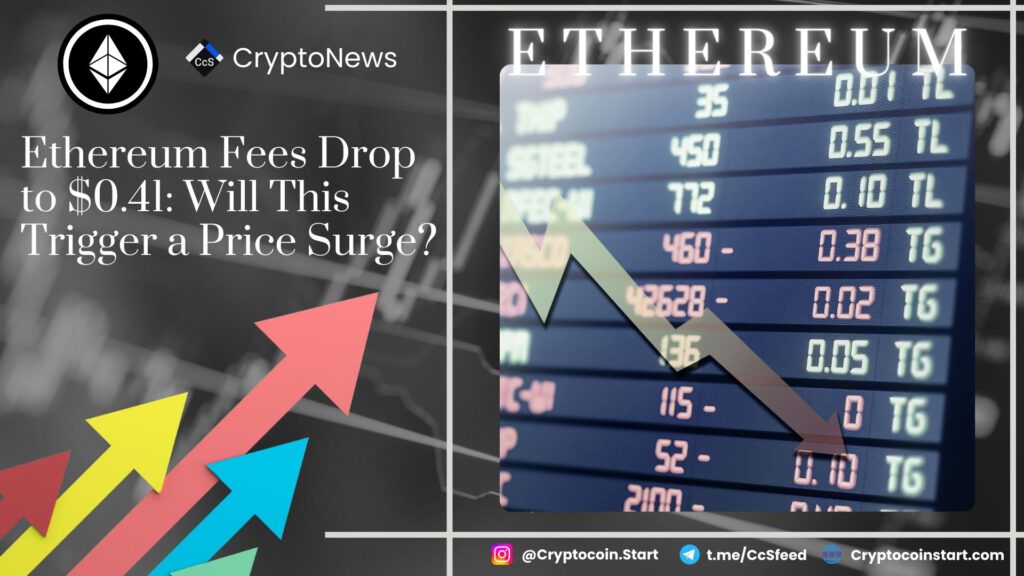
Ethereum’s Transaction Fees Drop to Multi-Year Lows – Is a Major Rally on the Horizon?
Ethereum has made headlines again as its transaction fees have plummeted to just $0.40 – the lowest since July 2020. This sharp decline, with the 7-day average tumbling 70% to $0.77 earlier this week, has slashed costs from January’s high levels, sparking bullish sentiment among investors. As ETH currently sits at $2,819, many analysts are predicting a potential price explosion as adoption increases due to the lower fees.
Key Insights:
- Ethereum’s transaction fees dropped to $0.40, the lowest in years.
- The 7-day average of fees dropped by 70% from January’s highs.
- With the lower fees, Ethereum is expected to see an increase in adoption, including more users, dApps, and DeFi activity.
- Resistance levels at $2,800 and $2,925 are in sight, and a bullish triangle on the daily chart could propel ETH past these levels.
Analysts are highly optimistic about Ethereum’s future. With the RSI currently hovering between 32 and 35, it is primed for a potential bullish reversal. If Ethereum’s volume increases to match January’s peak, ETH could break key resistance levels and surge past the $3,000 mark. Some analysts predict that the price could rise to between $3,600 and $5,800, while others foresee a 20-22% increase by the end of March.
PlutoChain ($PLUTO) Could Draw Whale Interest With Its Innovative Layer-2 Blockchain for Bitcoin
Another exciting development in the cryptocurrency world is the launch of PlutoChain ($PLUTO), which could draw significant whale attention due to its innovative approach to improving Bitcoin’s network. PlutoChain introduces a hybrid Layer-2 blockchain solution that enhances Bitcoin’s speed and scalability while preserving its trusted security features.
Key Features of PlutoChain:
- Can handle over 43,200 transactions a day, vastly improving Bitcoin’s scalability.
- Integrates smart contracts into Bitcoin, allowing the development of decentralized applications (dApps).
- Compatible with Ethereum Virtual Machine (EVM), making it easy for Ethereum developers to port their projects over to Bitcoin.
- Offers quick, low-cost transactions and DeFi features such as lending and staking.
Bitcoin’s current role as “digital gold” limits its real-world use cases, especially in the world of decentralized finance (DeFi). PlutoChain aims to change this by providing Bitcoin with the scalability, speed, and functionality it needs to compete more effectively with Ethereum and other blockchain networks. Although it is not expected to overtake Ethereum or Solana outright, PlutoChain could significantly enhance Bitcoin’s presence in the DeFi space.
Auditing and Governance
PlutoChain has undergone rigorous audits from respected firms like SolidProof, QuillAudits, and Assure DeFi, ensuring that its smart contracts and infrastructure meet high standards. Moreover, PlutoChain’s decentralized governance model empowers its community to participate in protocol decisions, fostering transparency and user involvement.
Conclusion
Ethereum’s recent drop in transaction fees to $0.40 could be the catalyst for its next major rally, with analysts predicting a price surge past $3,000, potentially reaching as high as $5,800. Lower fees typically drive higher adoption, which in turn fuels network activity and DeFi growth. On the other hand, PlutoChain’s introduction of smart contracts to Bitcoin could open new avenues for the cryptocurrency’s use beyond just digital gold, adding much-needed DeFi functionality and positioning Bitcoin as a more competitive player in the blockchain space.
Both Ethereum and PlutoChain are poised to bring exciting advancements to the crypto ecosystem, making them projects worth keeping an eye on in the coming months.

